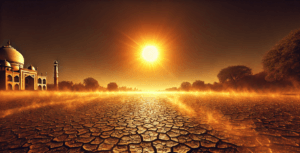Heatwaves in India: Understanding the Risks and Staying Safe
The India Meteorological Department (IMD) has issued heatwave warnings for several regions, increasing health risks due to extreme temperatures. Heatwaves are prolonged periods of unusually high temperatures, affecting both day and night. Climate change has intensified heatwaves, making them more frequent and severe. Trapped heat in the atmosphere leads to prolonged high temperatures, causing health issues like heat exhaustion, heatstroke, and dehydration. Vulnerable groups include children, the elderly, pregnant women, and those with medical conditions.
Heatwaves can also trigger heart attacks and kidney damage. To stay safe, drink plenty of water, wear light clothing, and use protective gear. Avoid outdoor activities during peak heat hours and minimize intake of dehydrating drinks like alcohol, tea, and coffee. Never leave children or pets in parked cars. Seek medical help if experiencing heat-related symptoms. Preventive measures are crucial to avoid life-threatening conditions.

Heatwaves in India: Understanding the Risks and Staying Safe
The Indian Ocean is heating up faster than ever, with temperatures rising by approximately 0.15°C per decade from 1951 to 2015, according to India’s Ministry of Earth Sciences (MoES). During a recent session in the Lok Sabha, Minister Jitendra Singh shared alarming data from advanced sea surface temperature records, highlighting that the northern Arabian Sea is warming at an even faster rate. This trend poses serious risks to weather patterns, marine life, and coastal communities.
Accelerated Warming in Key Regions
The northern Arabian Sea has experienced an annual temperature rise of 1.5°C over the past decade, while parts of the southern Arabian Sea have warmed by 0.75°C. When questioned by BJP MP Parshottam Rupala about worsening climate impacts, Singh attributed the extreme heat in the Indian Ocean to the fading phase of El Niño—a natural climate pattern responsible for 70–80% of marine heatwaves in the region. These heatwaves disrupt ocean ecosystems and contribute to stronger cyclones, erratic monsoons, and saltwater intrusion into freshwater sources.
Ripple Effects on Coastal Life
Rising ocean temperatures threaten not only marine species but also human populations. Frequent cyclones trigger storm surges, pushing saltwater inland. This salinity invasion contaminates drinking water, reduces crop yields, and damages delicate ecosystems such as wetlands and mangroves. These changes endanger livelihoods, particularly in fishing and farming communities that depend on coastal resources.
Marine Heatwaves: A Growing Crisis
The minister emphasized the sharp increase in marine heatwaves, particularly in the northern and southeastern Arabian Sea. Over recent decades, these heatwaves have lasted about 20 days longer each decade, disrupting marine habitats and fueling extreme weather events. Warmer oceans provide more energy for cyclones, leading to intense storms and unpredictable rainfall during the monsoon season.
A Hotter Future Ahead
Studies predict that the Indian Ocean—already the fastest-warming ocean basin—will heat up by 1.7°C to 3.8°C per century from 2020 to 2100 if current trends persist. This could result in more destructive weather events, prolonged marine heatwaves, and a significant decline in fish populations. Climate scientist Roxy Mathew Koll compared the projected heat increase to the energy released by detonating one Hiroshima atomic bomb every second for ten years. Such warming could collapse marine food chains, affecting millions who rely on the ocean for food and income.
Unusual Winter Heat in India
A separate study by U.S.-based Climate Central revealed that India experienced unusually high winter temperatures between December 2024 and February 2025. Ranking fifth in Asia for temperature anomalies, 12 Indian states—home to over 358 million people—experienced extreme heat. Maharashtra and Mizoram recorded winters 1.6°C hotter than normal, the highest in the country. Kristina Dahl, a Climate Central scientist, emphasized that climate change is already reshaping lives, with heatwaves becoming more frequent and intense due to fossil fuel emissions.
Global Heatwaves Intensify
Worldwide, over 394 million people endured dangerous heat during the same period, with African nations being the hardest hit. In 287 cities globally, residents faced at least a month of climate change-driven heat. These patterns underscore the urgent need for climate action to reduce emissions and adapt to rising temperatures.
The Time to Act is Now
The rapid warming of the Indian Ocean and its cascading effects—from fiercer cyclones to collapsing fisheries—underscore the immediate threat of climate change. Without drastic reductions in greenhouse gas emissions, extreme heat, erratic monsoons, and coastal disasters will continue to escalate, affecting food security, economies, and public health. As Minister Singh and scientists warn, the crisis is no longer a distant possibility but a present reality that demands urgent global cooperation and sustainable solutions.
You must be logged in to post a comment.